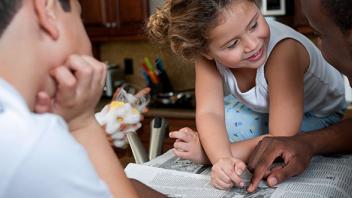Most families have access to a newspaper. Either one arrives on your doorstep or a local community paper is available for free at the coffee shop or grocery store. Even just a few pages from the newspaper can be turned into lots of early learning activities. Grab your young child and a pair of scissors, and let’s get learning with a newspaper!
Letters and words
Have your child cut out the letters needed to spell his first and last name. Have him glue these onto a piece of paper.
Ask your child to find capital and lower case pairs of letters. Glue the pairs onto a piece of paper.
Ask your child to find and cut out all the words in headlines that she can read. Paste them on a piece of paper and practice reading them together.
Writing
Cut out a few pictures from the paper. Ask your child to write a caption for each one. Compare their caption with the paper’s caption. Talk about ways captions help readers understand one small piece of the story.
Turn a recent family event into a newspaper story. Try to write a headline, the story, include a picture or drawing, and add a caption.
Ask your child to circle all the ads they can find in the paper. Discuss what makes a good advertisement and what does not. Discover what types of words and punctuation are often used in ads, and how those are tools writers use to capture a reader’s attention. See if your child can create an ad for their favorite game or TV show.
Understanding the news
Help your child understand the structure of the newspaper. Browse through the different sections of the newspaper. Sort news stories into international, national, and local. Point out other sections such as sports, food and entertainment.
Talk about the difference between fact and opinion. Then, read one of the articles from the newspaper. Are there facts in the story? Are there any opinions? How can we tell the difference? What sorts of words are used for each? Within which section are opinion stories usually found?
Choose an interesting and age-appropriate story from the newspaper. Read the story with your child. After reading, ask your child if she can answer the “who, what, where, when, and why” questions about the story.
Download this article in Spanish
Subscribe to Growing Readers!
Get our free monthly parent tips — in English and Spanish — delivered right to your inbox!
